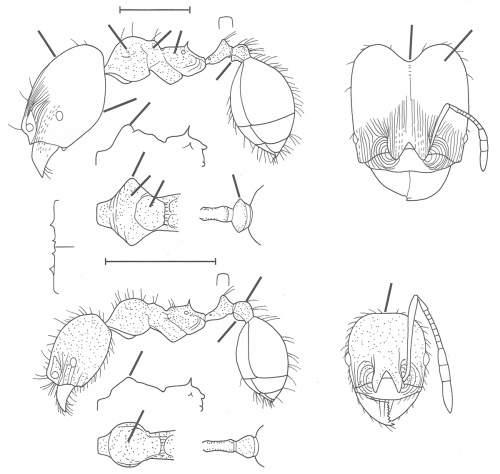Pheidole tristops
| Pheidole tristops | |
|---|---|
| Scientific classification | |
| Kingdom: | Animalia |
| Phylum: | Arthropoda |
| Class: | Insecta |
| Order: | Hymenoptera |
| Family: | Formicidae |
| Subfamily: | Myrmicinae |
| Tribe: | Attini |
| Genus: | Pheidole |
| Species: | P. tristops |
| Binomial name | |
| Pheidole tristops Wilson, 2003 | |
The type colony was found in rainforest. (Wilson 2003)
Identification
See the description in the nomenclature section.
Keys including this Species
Distribution
From Wilson (2003): Known from the type locality, and from Quebrado, Chirihara, Cundinamarca, Colombia, at 1400 m, col. William L. and Doris E. Brown.
Latitudinal Distribution Pattern
Latitudinal Range: 11.141647° to 1.422962°.
| North Temperate |
North Subtropical |
Tropical | South Subtropical |
South Temperate |
- Source: AntMaps
Distribution based on Regional Taxon Lists
Neotropical Region: Colombia (type locality).
Distribution based on AntMaps
Distribution based on AntWeb specimens
Check data from AntWeb
Countries Occupied
| Number of countries occupied by this species based on AntWiki Regional Taxon Lists. In general, fewer countries occupied indicates a narrower range, while more countries indicates a more widespread species. |

|
Estimated Abundance
| Relative abundance based on number of AntMaps records per species (this species within the purple bar). Fewer records (to the left) indicates a less abundant/encountered species while more records (to the right) indicates more abundant/encountered species. |

|
Biology
Castes
Nomenclature
The following information is derived from Barry Bolton's Online Catalogue of the Ants of the World.
- tristops. Pheidole tristops Wilson, 2003: 770, figs. (s.w.) COLOMBIA.
Unless otherwise noted the text for the remainder of this section is reported from the publication that includes the original description.
Description
DIAGNOSIS Similar in various ways to Pheidole balzani, Pheidole brunnescens, Pheidole exarata, Pheidole excubitor, Pheidole fabricator, Pheidole germaini, Pheidole hispaniolae, Pheidole nigella, Pheidole prattorum, Pheidole sabina, Pheidole sarpedon, Pheidole unicornis, and especially Pheidole tristis, differing as follows.
Major: head in side view with strongly convex ventral profile and weakly convex dorsal profile, the whole tapering strongly to the occiput; occipital cleft deep; humeri lobate, seen from above extending over the rest of the pronotum and from the side raised to a prominent discrete lobe; anterior half of postpetiolar venter in side view bearing an acute-angular process; postpetiolar node from above cone-shaped; all of mesosoma and waist foveolate and opaque.
Minor: occiput broad, lacking nuchal collar; humerus in dorsal-oblique view raised and subangulate; postpetiolar venter in side view strongly convex; all of body except gaster foveolate and opaque.
MEASUREMENTS (mm) Holotype major: HW 1.74, HL 1.86, SL 0.82, EL 0.14, PW 0.82. Paratype minor: HW 0.66, HL 0.74, SL 0.76, EL 0.10, PW 0.42.
COLOR Major: body and mandibles medium reddish brown; legs and antennae brownish yellow.
Minor: head, mesosoma, and petiole medium brown; antennae, mandibles, postpetiole and gaster light brown; legs dark yellow.
Figure. Upper: holotype, major. Lower: paratype, minor. Scale bars = 1 mm.
Type Material
COLOMBIA: 2-3 km above Minca, Magdalena, 650-950 m, col. William L. Brown. Museum of Comparative Zoology
Etymology
Gr L tristops, like tristis.
References
- Wilson, E. O. 2003. Pheidole in the New World: A dominant, hyperdiverse ant genus. Harvard University Press, Cambridge, MA. (page 770, fig. major, minor described)
- Franco, W., Ladino, N., Delabie, J.H.C., Dejean, A., Orivel, J., Fichaux, M., Groc, S., Leponce, M., Feitosa, R.M. 2019. First checklist of the ants (Hymenoptera: Formicidae) of French Guiana. Zootaxa 4674, 509–543 (doi:10.11646/zootaxa.4674.5.2).
References based on Global Ant Biodiversity Informatics
- Franco W., N. Ladino, J. H. C. Delabie, A. Dejean, J. Orivel, M. Fichaux, S. Groc, M. Leponce, and R. M. Feitosa. 2019. First checklist of the ants (Hymenoptera: Formicidae) of French Guiana. Zootaxa 4674(5): 509-543.
- Leponce M., J. H. C. Delabie, J. Orivel, J. Jacquemin, M. Calvo Martin, and A. Dejean. 2019. Tree-dwelling ant survey (Hymenoptera, Formicidae) in Mitaraka, French Guiana, in Touroult J. (ed.), “Our Planet Reviewed” 2015 large-scale biotic survey in Mitaraka, French Guiana. Zoosystema 41 (10): 163-179.
